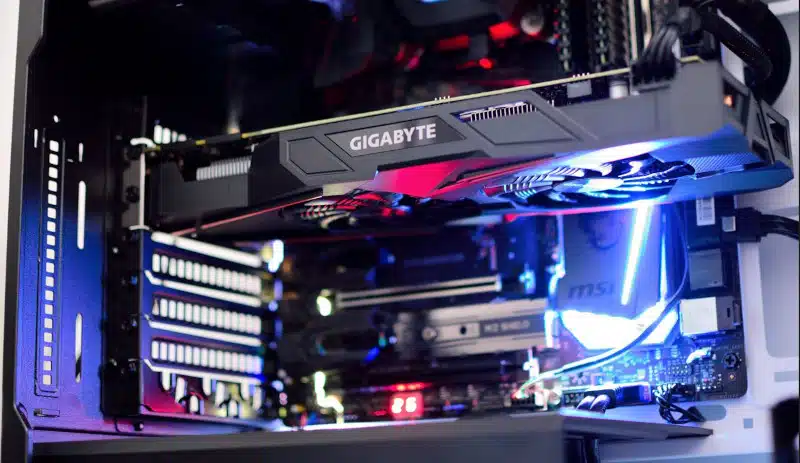Is your GPU acting up lately? Are you experiencing graphical glitches, system crashes, or performance hiccups while gaming or running graphics-intensive applications? If so, your graphics processing unit (GPU) might be showing signs of aging or even nearing its end. In this blog post, we’ll explore the telltale signs that your GPU is dying and help you decide if it’s time to upgrade.
5 Signs Your GPU is Dying
1. Graphic Artifacts and Glitches:
One of the first noticeable signs of a dying GPU is the appearance of graphic artifacts or glitches on your screen. These can manifest as random lines, distorted textures, flickering pixels, or complete screen freezes. If you start witnessing these anomalies while performing tasks that were once handled without issues, your GPU is likely struggling to keep up.
2. Overheating and Fan Noise:
As GPUs age, their cooling systems can become less efficient due to accumulated dust or worn-out fans. If you notice your GPU running hotter than usual or hear increased fan noise, it may indicate impending failure. Overheating can lead to thermal throttling, causing your GPU’s performance to drop significantly and potentially triggering unexpected shutdowns or system instability.
3. Reduced Performance and Slowdowns:
When a GPU is on its last leg, you may experience a noticeable decrease in performance. Games that used to run smoothly might become sluggish, frame rates may drop significantly, or you may encounter frequent stutters and lag spikes. If these issues persist despite driver updates and system optimizations, it’s a strong indication that your GPU is struggling to keep up with the demands of modern applications.
4. Blue Screen of Death (BSOD) and System Crashes:
Your GPU could be the culprit if your computer frequently crashes to a blue screen or experiences sudden system reboots while under a heavy graphics load. These crashes are often accompanied by error codes related to the graphics subsystem. While BSODs can have various causes, a failing GPU should be considered a potential source of the problem.
5. Artifacts in GPU Stress Tests:
If you suspect your GPU is dying, a stress test can help confirm its condition. During a stress test, your GPU is pushed to its limits, and if it’s faulty, it may exhibit artifacts, crashes, or even cause the system to freeze. Numerous stress test applications are available that can assess the stability and health of your GPU, providing valuable insights into its overall condition.
What to Do When You Encounter These Signs
1. Backup Your Data:
If you notice any indications of GPU failure, it is crucial to prioritize protecting your data before proceeding. You should back up your important files, documents, and media to an external storage device or cloud service. This precautionary measure ensures you won’t lose valuable data even if your GPU fails completely.
2. Update Graphics Drivers:
Outdated or faulty graphics drivers can sometimes cause issues that mimic GPU failure symptoms. Therefore, updating your GPU drivers to the latest version the manufacturer provides is recommended. Visit the official website of your GPU manufacturer or use their dedicated software to download and install the most up-to-date drivers. This step might resolve some software-related problems and improve overall stability.
3. Clean and Inspect Your GPU:
Dust accumulation can impede airflow and cause overheating, leading to GPU malfunctions. Carefully remove your GPU from the system and clean it using compressed air or a soft brush to remove any dust or debris. Take this opportunity to inspect the card for any visible physical damage, such as bulging or leaking capacitors. Although rare, these issues can also cause GPU failure.
4. Monitor Temperatures and Usage:
Installing monitoring software such as GPU-Z or MSI Afterburner can provide your GPU’s real-time temperature readings and usage statistics. Keep an eye on the temperature levels while running demanding applications or games. If your GPU consistently exceeds its optimal temperature range, it might indicate a cooling problem or deteriorating thermal paste. Monitoring usage can help identify patterns of GPU strain and potential triggers for failure.
5. Consider Professional Assistance:
If the signs of GPU failure persist or worsen despite your best efforts, it might be time to seek professional assistance. Reach out to a knowledgeable computer technician or contact the customer support of your GPU manufacturer for further guidance. They can provide diagnostics, suggest appropriate solutions, or advise whether a replacement GPU is necessary.
Proactive Measures to Maintain a Healthy GPU
As your GPU ages, it’s natural to show signs of wear and tear. By being aware of the indicators discussed in this blog post, you can take timely action to address potential issues and ensure the smooth functioning of your system. Remember to back up your data, update drivers, clean your GPU, monitor temperatures, and seek professional assistance. While some problems can be resolved, if your GPU is on its last leg, it might be a sign that it’s time to consider an upgrade and explore the latest graphics card options.
In summary, monitoring and recognizing signs of GPU deterioration can save you from unexpected system failures and data loss. Stay vigilant, take appropriate measures, and make informed decisions regarding your GPU’s health.
If you’re in Davenport, FL, and require professional assistance with your GPU or any other computer-related issues, contact PCMechanic Computer Repair. I can diagnose GPU problems, provide expert advice on upgrades, and ensure your system runs at its best. Don’t hesitate to contact PCMechanic for reliable and efficient computer repair services.


